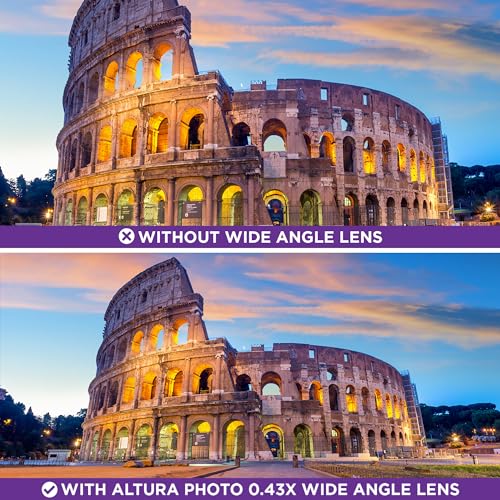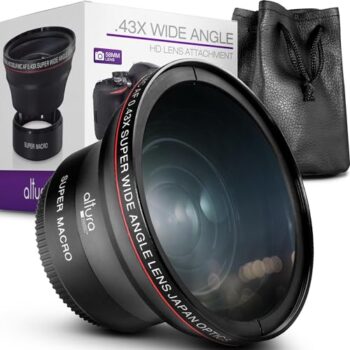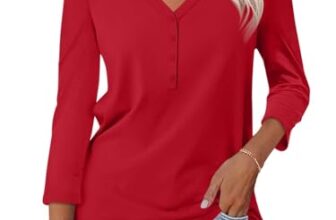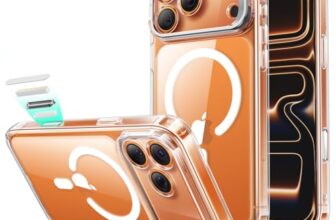Altura Photo 58mm Wide-Angle Macro Lens Review: The Ultimate Gateway to Creative Photography
Introduction: Expanding Your Vision Beyond the Kit Lens
For the aspiring photographer who has just begun their journey with a new DSLR or mirrorless camera, there comes a moment of creative limitation. The standard 18-55mm kit lens, while a versatile starting point, can feel creatively confining. The desire to capture the vast expanse of a breathtaking landscape, the full scope of a tight interior space, or the intricate, hidden world of a tiny flower often seems out of reach, locked behind the prohibitively high cost of specialized, professional lenses. It is this crucial gap—between creative ambition and financial reality—that the Altura Photo 58MM 0.43x HD Wide Angle Lens with Macro is brilliantly designed to fill. This is not a standalone lens, but an ingenious, dual-purpose optical attachment that acts as a powerful and accessible gateway to two of the most exciting genres of photography: ultra-wide-angle and macro.
This accessory represents a paradigm shift for the budget-conscious creator. It is an affordable tool for experimentation, a device that allows you to explore new perspectives and techniques without a massive financial commitment. By simply screwing onto the front of your existing lens, it instantly and dramatically alters its character. The 0.43x wide-angle converter transforms your standard view into an expansive panorama, perfect for real estate, vlogging, and grand scenic shots. Then, with a simple twist, the front element detaches to reveal a powerful macro lens, unlocking the ability to capture extreme, high-resolution close-ups of subjects that were previously just a blur. This is a product that understands its audience—the student, the hobbyist, the burgeoning content creator—and provides them with a tangible, hands-on tool to elevate their craft. In this comprehensive technical review, we will dissect the optical principles behind this clever converter, analyze its real-world performance and limitations, and demonstrate why it stands as one of the most valuable and impactful accessories a new photographer can add to their kit.

A Deep Dive into the Key Features: A Technical Dissection of a Dual-Purpose Optic
The Altura Photo lens attachment’s immense popularity is not based on a single function, but on its clever, multi-faceted design that offers two distinct creative tools in one compact package. Let’s analyze the core components from a technical perspective to understand how it works and what to expect.
-
The Science of Expansion: The 0.43x Wide-Angle Converter
The primary function of this attachment is to serve as a wide-angle converter. It is an afocal optical system, meaning it takes collimated light (light rays that are parallel) from a distant object and outputs collimated light, but with a magnified or, in this case, de-magnified angle of view. The 0.43x magnification factor is the key specification. From an optical physics standpoint, this number acts as a multiplier for the focal length of your host lens. For example, when attached to a standard Canon EF-S 18-55mm kit lens set to its widest focal length of 18mm, the effective focal length becomes 18mm * 0.43 = 7.74mm. This is a dramatic transformation. On an APS-C sensor (like those found in Canon Rebel or Nikon DX cameras), this converts the standard wide-angle view of the kit lens (approx. 29mm full-frame equivalent) into an ultra-wide field of view (approx. 12.4mm full-frame equivalent). This instantly “expands the field of view for breathtaking wide-angle photography.” This newfound perspective is a powerful creative tool. For landscape photographers, it allows for the capture of vast, sweeping vistas. For real estate agents or architectural photographers, it is essential for shooting tight interior spaces. For vloggers, it allows them to capture more of their background and create a more engaging, immersive frame when filming themselves at arm’s length.

-
Unlocking the Miniature World: The Detachable Macro Lens
Ingeniously integrated into the wide-angle converter is a powerful secondary function. By unscrewing the front optical group of the attachment, you are left with the rear element, which functions as a dedicated macro lens. Technically, this is a type of close-up diopter. It is a simple positive lens that shortens the minimum focusing distance of your existing camera lens. A standard lens, like an 18-55mm, might have a minimum focusing distance of about 10-15 inches, making it impossible to get truly close to very small subjects. When you attach this macro component, it allows the host lens to achieve focus at a fraction of that distance, often just a few inches from the front of the lens. This enables you to achieve a much higher magnification ratio, allowing for extremely high-resolution close-ups of small objects. This feature opens up an entirely new genre of photography. You can capture the intricate patterns on a flower petal, the delicate details of an insect’s wing, the texture of a piece of fabric, or the bubbles in a carbonated drink. This dual-functionality provides incredible value, giving the user two distinct creative tools in one affordable and easy-to-carry package.

-
The Universal Key: Understanding 58mm Lens Compatibility
This is the most critical technical point for a potential buyer to understand. The product description correctly and emphatically states: “PLEASE VERIFY YOUR CAMERA’S LENS THREAD SIZE BEFORE ORDERING. This Wide-Angle is compatible with 58MM lenses only.” This attachment does not connect to the camera body’s mount (like a standalone lens); it screws directly onto the filter threads at the very front of your existing lens. The “58MM” refers to the diameter of these threads. The lens thread size is a universal standard, which is why this single attachment is compatible with lenses from Canon, Nikon, Olympus, Panasonic, and Fujifilm. The key is that the specific lens you own must have a 58mm thread. The product lists a wide range of popular 58mm lenses, including the ubiquitous Canon EF-S 18-55mm kit lens that comes with most Canon Rebel cameras (T7, T8i, etc.), as well as telephoto zooms like the EF-S 55-250mm and various prime lenses. Your lens’s thread size is almost always marked on the front of the lens barrel or printed on the back of your lens cap, always preceded by a “Ø” (diameter) symbol. For example: Ø58 means you have a 58mm lens thread size. This universal screw-on design is what makes the accessory so accessible and easy to use.

-
Optical Construction and Performance Considerations
The “HD” designation in the product title implies that the attachment is constructed with High Definition optical principles in mind. This typically means the glass elements feature multi-layer coatings. These microscopic coatings are applied to the lens surfaces to reduce reflections. In any optical system, a certain percentage of light reflects off each glass surface, which can cause internal reflections that manifest as lens flare (starbursts or veiling glare when shooting into a light source) and ghosting (secondary images of the light source). Multi-coating helps to maximize light transmission for a brighter image and minimize these undesirable artifacts, leading to better contrast and color saturation. However, it is critical to have realistic expectations about the optical performance of any wide-angle converter. Adding a large group of optical elements to the front of a lens that was not designed for it will inevitably introduce some optical compromises. Users should expect some degree of:
- Barrel Distortion: This is an optical effect where straight lines near the edges of the frame appear to curve outwards, like the staves of a barrel. This is a common characteristic of very wide-angle perspectives and can often be corrected in post-processing software.
- Corner Softness: The image will likely be sharpest in the center and become progressively softer towards the extreme corners. This is a physical limitation of bending light at such an extreme angle through an auxiliary optic.
- Chromatic Aberration: There may be an increase in color fringing (purple/green halos) in high-contrast areas, especially near the edges of the frame.

Pros: The Undeniable Technical Strengths
- Incredible Value Proposition: Provides both ultra-wide-angle and macro capabilities for a tiny fraction of the cost of two dedicated, standalone lenses.
- Excellent Tool for Learning and Experimentation: Allows beginners and students to explore new photographic genres and understand different focal lengths without a major financial investment.
- True Dual-Functionality: The clever two-piece design allows the macro component to be used independently, providing two distinct creative tools in one.
- Universal Screw-On Compatibility: The 58mm thread design makes it compatible with a huge range of popular kit and prime lenses across multiple camera brands.
- Extremely Easy to Use: The simple screw-on mechanism requires no technical knowledge and can be attached or detached in seconds.
- Compact and Portable: Significantly smaller and lighter than carrying a dedicated ultra-wide zoom and a separate macro lens, making it ideal for travel.

Cons: Important Technical Considerations and Limitations
- Inevitable Optical Compromises: As an auxiliary converter, it will degrade the host lens’s image quality, introducing noticeable corner softness, barrel distortion, and increased chromatic aberration.
- Performance is Host-Lens Dependent: The final image quality is directly tied to the optical quality of the lens it is attached to. It will perform better on a sharp prime lens than on a soft kit lens.
- Potential for Vignetting: The attachment can sometimes cause vignetting (darkening of the corners of the image), especially when used at the widest setting of a zoom lens.
- Impact on Autofocus: The camera’s autofocus system has to work through additional glass elements, which can sometimes result in slower or less reliable AF performance, particularly in low light.
- Adds Bulk and Front-Heaviness: The attachment adds noticeable weight and length to the front of the camera lens, which can affect the balance and handling of the camera.
Conclusion: The Ultimate Creative Catalyst for the Aspiring Photographer
The Altura Photo 58MM 0.43x HD Wide Angle Lens with Macro is a brilliantly conceived and perfectly positioned product. It is crucial to evaluate it not in a vacuum against professional-grade lenses costing thousands of dollars, but for what it is: an incredibly affordable and accessible tool designed to break down creative barriers. In that context, it is an overwhelming success. It delivers on its promise of providing a true ultra-wide-angle perspective and a powerful macro capability in a single, easy-to-use, and astonishingly inexpensive package. Yes, it comes with optical compromises—that is the inescapable physics of afocal converters. However, for the intended audience, these trade-offs are a small price to pay for the immense creative doors that are opened.
This is the perfect accessory for the photography student who needs to experiment with different genres for a class project. It’s for the new vlogger who wants to achieve a more professional-looking wide shot without buying a new lens. It’s for the hobbyist who is curious about the miniature world of macro photography but isn’t ready to invest in dedicated gear. The Altura Photo attachment is a catalyst. It’s a tool that encourages experimentation, teaches the principles of different focal lengths, and, most importantly, allows you to capture shots that would otherwise be impossible with your standard kit. For its intended purpose and its incredible value, it is an essential, must-have piece of kit for any beginner or enthusiast photographer looking to expand their vision.
Frequently Asked Questions (FAQs)
- Q1: To be absolutely clear, will this fit my Canon Rebel T7 camera?
- A: It will fit the LENS that came with your Canon Rebel T7, provided it is the standard EF-S 18-55mm kit lens, which has a 58mm filter thread. This attachment does NOT connect to the camera body itself. You must always check the filter thread size (the “Ø” symbol) on the specific lens you intend to use it with.
- Q2: What is the main technical difference between using this and buying a “real” ultra-wide-angle lens?
- A: A “real” or “dedicated” ultra-wide-angle lens is a complete optical system designed from scratch to produce a wide field of view with the highest possible image quality. It will be significantly sharper, especially in the corners, and have far less distortion and chromatic aberration. This attachment is an auxiliary optic that modifies the light path of your existing lens, which is a much more complex task that inevitably leads to some degradation in image quality, but at a tiny fraction of the cost.
- Q3: Will my camera’s autofocus and image stabilization still work with this attached?
- A: Yes, both systems will still function. However, the autofocus may be slightly slower or less decisive because the camera’s AF sensor is looking through the extra glass. The image stabilization of your host lens will also still work, which is a great benefit for handheld shooting.
- Q4: How do I switch between the wide-angle and macro functions?
- A: The attachment comes as two pieces screwed together. When both pieces are attached, it functions as a wide-angle converter. To use the macro function, you simply unscrew the front, larger glass element. The smaller piece that remains attached to your camera lens is the macro lens.
- Q5: Can I still use filters, like a polarizer or ND filter, with this attachment?
- A: Yes. The front of the wide-angle attachment itself has filter threads. You will need to check the size, but it is typically a larger thread size (e.g., 67mm or 72mm). You would then need to buy filters in that larger size to use on the front of the converter.
- Q6: Is this attachment good for professional real estate photography?
- A: For professional, paid real estate work where clients demand the highest quality, a dedicated ultra-wide-angle lens is the required tool. However, for a real estate agent who just wants to take wider, more comprehensive photos for an online listing themselves, this attachment is an incredibly cost-effective tool to get the job done and make their photos look much better than what a standard kit lens can produce.

See more posts in the category Lens.







